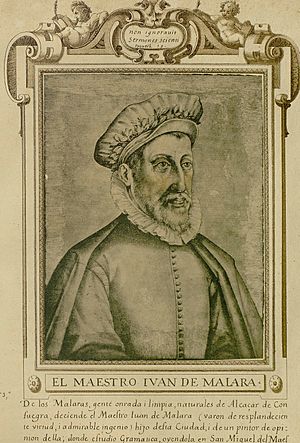Juan de Mal Lara facts for kids
Juan de Mal Lara (born in Sevilla in 1524, died in Sevilla in 1571) was an important Spanish thinker during the Spanish Renaissance. He was a humanist, which means he studied classical subjects like ancient Greek and Roman culture. He was also a poet, a playwright (someone who writes plays), and a paremiologue. A paremiologue studies proverbs and wise sayings. He taught at the University of Seville during the time of Philip II of Spain.
Contents
Juan de Mal Lara's Life
Juan de Mal Lara started his education in Sevilla. He learned Latin and Greek grammar at the College of San Miguel. His teacher was Pedro Fernandez de Castilleja. Later, Mal Lara himself taught humanities to famous students like Mateo Alemán.
After studying in Sevilla, he went to the University of Salamanca. There, he was a student of Hernán Núñez. One of his classmates was Francisco Sánchez de las Brozas. Mal Lara also studied in Valencia and Barcelona before returning to Salamanca. In 1548, he came back to Seville to continue his studies. By 1550, he was teaching humanities and literature at a grammar school in Sevilla.
In 1565, a special group of writers and thinkers started meeting in Sevilla. This group was called the "Sevillian Poetry School." Mal Lara was part of this group, along with other famous people like Baltasar del Alcázar and Fernando de Herrera. They met at a place called "Merlin's Garden."
Mal Lara faced an investigation by the Spanish Inquisition in 1561. This was a powerful religious court in Spain. However, he was found innocent of all charges in 1566. That same year, he moved to Madrid to work at the royal court of King Philip II of Spain. King Philip II was known as 'the prudent' because he was a smart ruler. He especially enjoyed studying the works of the Roman speaker Marcus Tullius Cicero. This is why, even today, a serious but informal discussion in Spanish is called "una tertulia" (a gathering).
At the royal court, Mal Lara wrote poems to go with paintings by the famous artist Titian. He was also asked to create special designs and writings for the flag of Don Juan de Austria's main ship, the "royal galley of Serene Don Juan de Austria, Captain of all the Seas."
Juan de Mal Lara married Maria de Ojeda. They had two daughters named Gila and Silvestra. He also worked with important historians like Gonzalo Argote de Molina. Some people believe he invented the "décima." This is a special type of poem with ten lines. It became very popular thanks to Vicente Espinel, so it's also known as a "Spinel."
Mal Lara's Writings
During his lifetime, Mal Lara was most famous for two main books.
Philosophia vulgar
His first major work was Philosophia vulgar (published in Seville in 1568). The first part of this book contains "one thousand and one refrains." These are short, wise sayings or proverbs meant to be learned by heart. In the book, Mal Lara explained how much wisdom is hidden in these old sayings. This work was similar to Adagia by Erasmus of Rotterdam, another famous writer.
Rey Phelipe de Seuilla
His other important work was a tribute to King Philip II of Spain. Mal Lara wrote this book with Alonso Escribano in 1570. It praised the city of Sevilla for its warm welcome to King Philip. The book also described the beautiful decorations on the walls of Seville. These decorations had figures and poems that showed different parts of the city. This book was published after the king won against the Moorish rebellion of Alpujarras.
Other Works
Mal Lara wrote a mythological poem called Psyche. It was inspired by the story of Psyche and Cupid from a novel by Apuleius. This poem was not very popular at the time. He also wrote other works, including:
- Two eclogues (poems about country life) called Narciso and Laurea.
- Annotations to the syntax of Erasmus.
- A philosophical book called Pilgrimage of life.
- Principles of Grammar.
- Notes on Emblems of Andrea Alciato.
- Scholia of Rhetoric on the introductions of Aphthonius of Antioch (notes on how to speak well).
- Chronicle of the Holy Apostles.
- A poem in octaves (eight-line stanzas) called The Death of Orpheus.
- A Latin poem called The Martyrdom of Saints Justa and Rufina, patron of Seville.
Plays
Mal Lara also wrote plays. Some of his notable dramatic works include:
Both of these plays were first performed at the University of Salamanca in 1548. They were written in both Latin and Castilian (Spanish). He continued writing plays in Seville. In 1561, his students performed his comedy In praise of Our Lady of Consolation in Utrera. Another play, Tragedy of San Hermenegildo, is believed to be lost.
The Spirited Hercules
One of his most praised poetic works was The Spirited Hercules. For a long time, people thought this work was lost. But a copy was found in the Ajuda National Palace in Portugal. This long poem is divided into twelve books, each with four songs. It tells the story of the twelve mythological feats of Hercules. But Mal Lara used these stories to praise twelve victories of King Philip II's grandfather. For example, the Nemean lion in the poem stood for the Revolt of the Comuneros, and the Erymanthian Boar represented Francis I of France.
The poem ends with King Philip II being seen as a new Hercules, helping Atlas. Mal Lara started this work in 1549, but he died suddenly before he could finish it and have it printed.
Today, you can find Mal Lara's surviving poems in Volume XLII of the Biblioteca de Autores Españoles. His complete works were published in three volumes in 1996.
See also
 In Spanish: Juan de Mal Lara para niños
In Spanish: Juan de Mal Lara para niños


